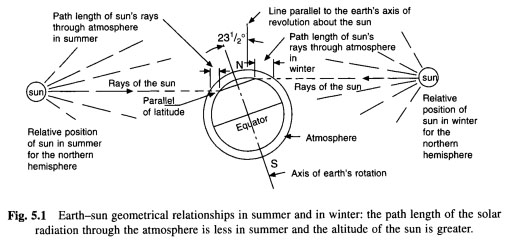Climate
Fluctuations of temperature, humidity and wind occurring worldwide due to a number of factors integration, which for a particular locality, provides climate experienced. There, first, seasonal changes of climatic conditions, depending on latitude and due to the fact that, because of earth's rotational axis is tilted about 23.5 to its axis of rotation around the sun, the amount of solar energy received at a certain point on the surface of the earth changes during the year. The geography of the terrain provides a second factor influential in the field of climate change in the framework imposed by seasonal fluctuations.
On Fig. 5.1 shows geometric considerations which show that, in particular latitude, the earth receives less solar radiation in winter than in summer. The importance of this its impact on the seasons is that for all practical purposes, the sun is the only supplier of energy for the earth.

The geography of the place determines how much solar energy is absorbed by the earth, how much is stored and how readily it is released into the atmosphere.
The atmosphere is relatively transparent to the flow of radiant solar energy (called " insolation"), and sushi, which receive energy are not transparent and are pretty good shock absorption, although this depends on the reflectivity of the surface. This means that the heat energy of the sun heats the surface of the land on which it falls. Part of this energy travels inside and stored in the upper layers of the earth's crust; some convected to the atmosphere and some re-radiated back into space, but in a longer wavelength (about 10 microns), since the average surface temperature is much smaller than the sun. Four-fifths of the earth's surface water, not land, and water behaves differently as a receiver of solar insolation, being partially transparent to him, and, therefore, the energy is absorbed by water in depth, causing the temperature of its surface not reach such a high value in the daytime.
On the other hand, at night, the heat loss from the earth to the sky much faster as there is less to be stored in its shallow upper crust than was absorbed and stored in deep water layers. The result is that the land-surface temperatures are generally below at night, than the water temperature on its surface. It is obvious that the places in the centre of large land masses will tend to have more extreme annual variations in temperature, which will island in the great sea. Thus, the climate of places on the same latitude, may be very different. To realize this goal, we have but to compare the temperate seasons experienced British Isles with extremes suffered in Central Asia and Northern Canada, roughly on the same latitude.
Exchanges of radiant energy, cited above, as responsible for the differences in the Maritime and continental climate is complicated somewhat by the number of cloud. Cloud cover acts as an insulating barrier between the earth and its environment; it not only reflects back into space a good deal of solar energy falling on it, but it also blocks the passage of low frequencies infra-red radiation that the earth radiates. In addition, the amount of carbon dioxide in the atmosphere reduces the emission of infra-red radiation. Mountain ranges also play a role in changing the simple picture presented above radiation balance.
Due to uneven heating of land and sea produce to the movement of air. This movement of the air leads adiabatic compression and expansion occurring in the atmosphere and consequently decreases or increases, respectively, the temperature of air. These temperature changes, in turn, can lead to the formation of clouds, and the values below the dew point is reached.
One common aspect of thermal radiation balance prominent place in affecting our weather and in the production of permanent traffic data, such as the trade winds and Depression. It is a fact that, at high latitudes, the earth loses more heat to space radiation than it receives from the sun, but, for the lower latitudes, in the opposite case. As a result of lower latitudes heat and higher cool. This generates heat up-current from the Equatorial regions and relevant down-current at high latitudes. While this is true for the perfect atmosphere, the fact that the earth revolves, and that other complicating factors are present means that the actual behavior is quite involved, and not yet fully understood...
|

